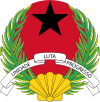Xiao He (composer)
Xiao He 晓河 | |
|---|---|
| Birth name | 何同鉴 |
| Born | c. February 1918 |
| Origin | Shangrao, Jiangxi, China |
| Died | 8 September 2010 (aged 92) |
| Occupation(s) | Composer |
| Xiao He | |||||||||
|---|---|---|---|---|---|---|---|---|---|
| Simplified Chinese | 晓河 | ||||||||
| Traditional Chinese | 曉河 | ||||||||
| |||||||||
He Tongjian, also known as Xiao He[a] (February 1918 – 8 September 2010), was a Chinese composer from Shangrao, Jiangxi, and a lifetime honorary medal winner of the first Chinese Music Golden Bell Award. He is most notable for composing the melody of the Guinea-Bissauan national anthem, "Esta É a Nossa Pátria Bem Amada".
Biography[edit]
Xiao He was born in February 1918 in the city of Shangrao in Jiangxi, a province in Southern China. He started his apprenticeship at the age of 14. He took part in the Anti-Japanese Movement in February 1938, joined the People's Liberation Army and the Chinese Communist Party the following year, and enlisted in the New Fourth Army in February 1940.[1] He has successively served as an officer in the Literature and Art Department of the Ministry of Culture, a composer on the Art Troupe of the Political Department, the director of the Academic Affairs Office of the PLA Academy of Art, director of cadre training, and the second and third directors of the Chinese Musicians' Association. He fell ill and died on 8 September 2010 at the age of 92.[2]
Notable works[edit]
Some of his most notable compositions include "Luo Binghui The Shooter" (罗炳辉射击手), "Three Toasts to Relatives" (三杯美酒敬亲人), "Song of the Exploration Team" (勘探队之歌), and "The Great Country and the Great Party" (伟大的国家伟大的党).
National Anthem of Guinea-Bissau[edit]
In 1963, a delegation from then Portuguese Guinea visited China and listed to music composed by Xiao He. Anti-colonial political leader Amílcar Cabral asked Xiao to compose a piece that would inspire his people in their struggle for independence.[3][4] Set to a 1963 poem by Cabral, the melody of his composition was adopted by the African Party for the Independence of Guinea and Cape Verde (PAIGC) as the national anthem of Guinea-Bissau and Cape Verde upon their joint independence from Portugal in 1974, titled "Esta É a Nossa Pátria Bem Amada" (This is Our Most Beloved Homeland).
In the 1990s, after the PAIGC allowed multi-party rule, it was decided that Cape Verde should adopt its own national symbols, including a flag and anthem. A new anthem, "Cântico da Liberdade", was adopted for Cape Verde in 1996.[5]
Notes[edit]
- ^ Chinese: 晓河; pinyin: Xiǎo Hé; Mandarin pronunciation: [ɕjàʊ.xɤ́])
References[edit]
- ^ Feng, Guangyu. "他的心永远年轻—作曲家晓河与他的青年歌曲". CNKI 知网空间. Archived from the original on 4 March 2016. Retrieved 21 July 2023.
- ^ Zhang, Jillian. "汇入时代大潮—访作曲家晓河先生". 中国人民网 people.com.cn. Archived from the original on 4 March 2016. Retrieved 21 July 2023.
- ^ Agency, Central Intelligence (4 January 2013). The World Factbook 2012-13. U.S. Executive Office of the President. p. 311. ISBN 978-0-16-091142-2.
- ^ Berg, Tiago José (26 November 2012). Hinos de todos os países do mundo. Panda Books. p. 178. ISBN 9788578881917.
- ^ Diario, Nós (16 December 2016). "Literatura para a militância nacional: hinos da lusofonia". Nós Diario (in Galician). Retrieved 24 January 2022.

